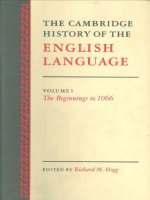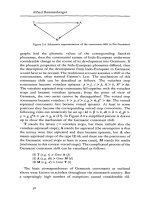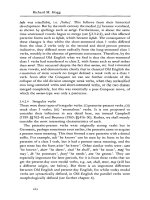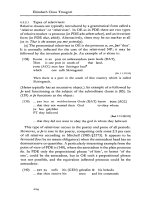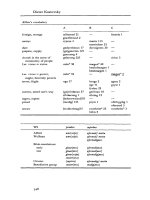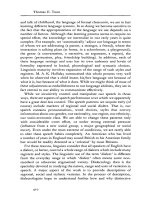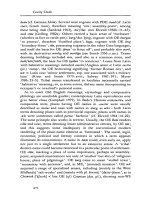The cambridge history of china volume 14 the peoples republic, part 1 the emergence of revolutionary china 1949 1965
Bạn đang xem bản rút gọn của tài liệu. Xem và tải ngay bản đầy đủ của tài liệu tại đây (40.51 MB, 688 trang )
THE CAMBRIDGE HISTORY
OF CHINA
General editors
D E N I S T W I T C H E T T and J O H N K. FAIRBANK
Volume 14
The People's Republic, Part 1:
The Emergence of Revolutionary China 1949-1965
Cambridge Histories Online © Cambridge University Press, 2008
Tai Lieu Chat Luong
Cambridge Histories Online © Cambridge University Press, 2008
THE CAMBRIDGE
HISTORY OF
CHINA
Volume 14
The People's Republic, Part 1:
The Emergence of Revolutionary China
1949-1965
edited by
RODERICK M A C F A R Q U H A R
and
J O H N K. FAIRBANK
CAMBRIDGE
UNIVERSITY PRESS
Cambridge Histories Online © Cambridge University Press, 2008
Published by the Press Syndicate of the University of Cambridge
The Pitt Building, Trumpington Street, Cambridge CB2 1RP
40 West 20th Street, New York, NY 10011-4211, USA
10 Stamford Road, Oakleigh, Melbourne 3166, Australia
© Cambridge University Press 1987
First published 1987
Reprinted 1989, 1995
Printed in the United States of America
Library of Congress Gualoging-in-Publication
Data is available.
A catalogue record fir this book is available from the British Library.
ISBN 0-521-24336-X hardback
Cambridge Histories Online © Cambridge University Press, 2008
GENERAL EDITORS' PREFACE
As the modern world grows more interconnected, historical understanding of it becomes ever more necessary and the historian's task
ever more complex. Fact and theory affect each other even as sources
proliferate and knowledge increases. Merely to summarize what is
known becomes an awesome task, yet a factual basis of knowledge
is increasingly essential for historical thinking.
Since the beginning of the century, the Cambridge histories have
set a pattern in the English-reading world for multivolume series
containing chapters written by specialists under the guidance of
volume editors. The Cambridge Modern History, planned by Lord
Acton, appeared in sixteen volumes between 1902 and 1912. It was
followed by The Cambridge Ancient History, The Cambridge
Medieval History, The Cambridge History of English Literature, and
Cambridge histories of India, of Poland, and of the British Empire.
The original Modern History has now been replaced by The New
Cambridge Modern History in twelve volumes, and The Cambridge
Economic History of Europe is now being completed. Other Cambridge histories include histories of Islam, Arabic literature, Iran,
Judaism, Africa, Japan, and Latin America.
In the case of China, Western historians face a special problem. The
history of Chinese civilization is more extensive and complex than
that of any single Western nation, and only slightly less ramified than
the history of European civilization as a whole. The Chinese historical record is immensely detailed and extensive, and Chinese historical
scholarship has been highly developed and sophisticated for many
centuries. Yet until recent decades the study of China in the West,
despite the important pioneer work of European sinologists, had
hardly progressed beyond the translation of some few classical
historical texts, and the outline history of the major dynasties and
their institutions.
Recently Western scholars have drawn more fully upon the rich
traditions of historical scholarship in China and also in Japan, and
Cambridge Histories Online © Cambridge University Press, 2008
VI
GENERAL EDITORS
PREFACE
greatly advanced both our detailed knowledge of past events and institutions and also our critical understanding of traditional historiography. In addition, the present generation of Western historians of
China can also draw upon the new outlooks and techniques of
modern Western historical scholarship, and upon recent developments in the social sciences, while continuing to build upon the solid
foundations of rapidly progressing European, Japanese, and Chinese
sinological studies. Recent historical events, too, have given prominence to new problems, while throwing into question many older
conceptions. Under these multiple impacts the Western revolution in
Chinese studies is steadily gathering momentum.
When The Cambridge History of China was first planned in 1966,
the aim was to provide a substantial account of the history of China
as a bench mark for the Western history-reading public: an account
of the current state of knowledge in six volumes. Since then the
outpouring of current research, the application of new methods, and
the extension of scholarship into new fields have further stimulated
Chinese historical studies. This growth is indicated by the fact that
the History has now become a planned fifteen volumes, but will still
leave out such topics as the history of art and of literature, many
aspects of economics and technology, and all the riches of local
history.
The striking advances in our knowledge of China's past over recent
decades will continue and accelerate. Western historians of this great
and complex subject are justified in their efforts by the needs of their
own peoples for greater and deeper understanding of China. Chinese
history belongs to the world, not only as a right and necessity but
also as a subject of compelling interest.
JOHN K. FAIRBANK
DENIS TWITCHETT
Cambridge Histories Online © Cambridge University Press, 2008
CONTENTS
p<*ge v
General editors' preface
List of maps
xi
List of tables
xii
Preface to volume 14
xiii
List of acronyms
xvi
1
The reunification of China
by J O H N K. F A I R B A N K , Professor of History,
Harvard University
Emeritus,
1
Phases of historical understanding
The Chinese achievement of unity
The role of modernization
The problem of local control
PART I : E M U L A T I N G T H E SOVIET M O D E L ,
1
11
23
38
1949-1957
2 Establishment and consolidation of the new regime
by F R E D E R I C K C. T E I W E S , Reader in Government,
The University of Sydney
An overview
Consolidation and reconstruction, 1949-1952
Socialist construction and transformation, 1953-1956
Adjusting the new socialist system, 1956-1957
3 Economic recovery and the 1st Five-Year Plan
by N I C H O L A S R. L A R D Y , Professor of International
Studies, University of Washington, Seattle
Cambridge Histories Online © Cambridge University Press, 2008
51
51
6j
92
122
144
VHl
CONTENTS
The economic setting
The 1 st Five-Year Plan
The formulation of the 2nd Five-Year Plan
4
5
6
Education for the new order
by S U Z A N N E P E P P E R, Associate, Universities Field Staff
International, Hong Kong
144
155
180
18 5
The heritage from the Republican era
The heritage of the Communist Border Regions
Learning from the Soviet Union
The 1950s in perspective
18 5
192
197
203
The Party and the intellectuals
by M E R L E G O L D M A N , Professor of History, Boston
University
218
The historical relationship between the intellectuals
and the government
Pre-1949 conflicts between Party and intellectuals
Establishment of Party control over intellectuals,
1949-1955
The Hundred Flowers Campaign
The Anti-Rightist Campaign
242
253
Foreign relations: from the Korean War to the Bandung
Line
by M I N E O N A K A J I M A , Professor, Tokyo University of
Foreign Studies
259
An overview
Leaning to one side: Mao Tse-tung and Stalin
The Korean War
The Bandung Line
218
220
234
259
262
270
283
PART I I : THE SEARCH FOR A CHINESE R O A D ,
1958-1965
7
The Great Leap Forward and the split in the Yenan
leadership
by K E N N E T H L I E B E R T H A L , Professor ofPolitical
Science, The University of Michigan
Cambridge Histories Online © Cambridge University Press, 2008
293
CONTENTS
An overview
Origins of the Great Leap Forward
The Lushan Conference, July 1959
After the Leap: the Liu-Teng program
The rise of Lin Piao
Rectification
IX
293
299
311
322
335
348
8 The Chinese economy under stress, 1958-1965
by N I C H O L A S R. LARDY
The economic strategy of the Great Leap Forward
The incidence of the Chinese famine
The Party's response to the famine crisis
Economic recovery, 1963-1965
9
360
363
372
378
391
New directions in education
by S U Z A N N E P E P P E R
The Great Leap in education: 1958
The aftermath: 1959-1960
Walking on two legs into the 1960s
398
400
411
415
10 The Party and the intellectuals: phase two
by M E R L E G O L D M A N
432
The denigration of intellectual endeavor in the Great
Leap Forward
The intellectual relaxation in the aftermath of the Great
Leap Forward
Resistance to Mao's ideological class struggle
The radical intellectuals
Party rectification, 1964-1965
434
450
455
463
11 The Sino-Soviet split
by A L L E N S. W H I T I N G , Professor of Political Science,
The University of Arizona
478
Phase one: 1958
Phase two: 1959-1960
Phase three: 1961-1962
Phase four: 1963-1964
Epilogue
by R O D E R I C K M A C F A R Q U H A R , Professor of
Government, Harvard University
Cambridge Histories Online © Cambridge University Press, 2008
432
481
501
519
525
539
X
CONTENTS
Bibliographical essays
Politics takes command: an essay on the study of
post- 1949 China
by M I C H E L O K S E N B E R G , Professor of Political Science,
The University of Michigan
The basic sources and their limitations
The English-language secondary literature
543
547
576
Bibliographical essays for chapters
591
Bibliography
609
Appendixes: meetings and leaders
660
Conversion tables: pinyin and Wade-Giles
66$
Glossary-index
671
Cambridge Histories Online © Cambridge University Press, 2008
MAPS
1
2
3
4
5
6
7
8
9
10
11
China's physical features
PRC: political (Wade-Giles romanization)
PRC: political {pinyin romanization)
Administrative regions, 1949-54
Agriculture: major cropping areas
Korean War
Railway construction between 1949 and i960
Offshore islands
Sino-Indian border
Sino-Indian hostilities, 1962
China and Southeast Asia
Cambridge Histories Online © Cambridge University Press, 2008
2
52
54
80
146
273
368
494
510
522
530
TABLES
1 Agricultural cooperatives: development and targets
2 Students in 1949
3 Graduates in 1949
4 Numbers of schools and students, 1949-1957
5 Urban and rural grain consumption, 1952-1965
6 Mortality rates, 1956-1962
7 Grain production and government transactions with the
rural sector, 1953-1965
8 Grain exports and imports, 1952-1965
9 Numbers of schools and students, 1958-1965
10 Party leadership, 1921-1928
11 High-level formal Party meetings, 1945-1965
12 Party leadership, 1945-1965
13 State leaders, 1949-1965
Cambridge Histories Online © Cambridge University Press, 2008
112
186
186
211
373
374
381
381
427
660
662
663
664
PREFACE TO VOLUME 14
In 1949 a new stage was reached in the endeavors of successive
Chinese elites to meet domestic problems inherited from the Late
Imperial era and to respond to the century-old challenge posed by the
industrialized West. A central government had now gained full
control of the Chinese mainland, thus achieving the national unity so
long desired. Moreover, it was committed for the first time to the
overall modernization of the nation's polity, economy, and society.
The history of the succeeding decades is of the most massive experiment in social engineering the world has ever witnessed. Volumes 14
and 15 of the Cambridge History of China attempt to chronicle and
analyze that experiment.
The very power and purposefulness of the Chinese Communist
regime have shaped the format of these volumes. Unlike in the imperial
and republican periods, under the Chinese Communists no aspect of
life, no region of the country has been immune from the determined
efforts of the central authorities to revolutionize China. It is simply
not meaningful to examine any part of Chinese society except in the
context of the Communist Party's efforts to transform it. Perforce,
one must start by looking at China from the viewpoint of the Party's
Politburo and the government's State Council in Peking.
The division of this volume into two sections has been dictated by
the major change in Party policy that took place in 1958 and affected
all sectors of society. The division between this volume and the
succeeding one reflects the watershed of the Cultural Revolution
launched by Mao Tse-tung in 1966.
Of course, the ideas, objectives, strategies, policies, and actions
of Chairman Mao, his colleagues, and his successors do not amount
to a history of China. The greater part of these two volumes is concerned with assessing the impact they have had on the Chinese
nation. Given the enormous quantity of new data released and the
easier access to the mainland allowed by the People's Republic in
Cambridge Histories Online © Cambridge University Press, 2008
XIV
PREFACE
recent years, it is possible now to delineate more clearly the outcomes
of the experiment so far.
Nevertheless, we are conscious that ours must be an interim
judgment - not so much because there remain vital data that have not
been released, for it is very likely that some never will be; nor because
the events we describe are so recent, for the assessments of historians
are continually subject to revision no matter how great the advantage
of distance; but because the experiment is far from over, and only
near its completion - a century hence? - will a rounded perspective
on these earliest decades be possible.
This is the fifth volume of The Cambridge History of China
covering the nineteenth and twentieth centuries. From the beginning
of this endeavor we have been conscious of our indebtedness to every
significant contribution to the field. Only our footnotes can tell that
story.
We can, however, express our gratitude to the experienced chief
manager and processor of this volume, Joan Hill, who pursues
precision with good humor, and a perseverance worthy of Chairman
Mao's Foolish Old Man Who Removed the Mountains. Chiang
Yung-chen has given us valuable assistance with the Chinese bibliography and calligraphy. Our thanks go also to Katherine Frost
Bruner and Gwendolyn Stewart for highly skilled indexing.
In January 1983, we ran a working conference of contributors
under the aegis of Harvard's Fairbank Center, which was excellently
organized by Patrick Maddox, assisted by Debra Knosp and generously financed by the Rockefeller Foundation. We are delighted to
acknowledge also with gratitude the support of the Ford and Mellon
foundations, which has been critical to sustaining the production of
these volumes, as well as the backing of the American Council of
Learned Societies and the National Endowment for the Humanities.
We are indebted to Harvard University and especially to Philip A.
Kuhn for assistance in his capacity as Center director.
RLM
JKF
ON ROMANIZATION
For purely technical reasons we continue, as in preceding volumes, to
use the Wade-Giles system for transcription of Chinese into alphabetic writing. The main reason is that, in order to avoid confusion, we
have to use here the forms used in previous volumes - for example,
Cambridge Histories Online © Cambridge University Press, 2008
PREFACE
XV
Chou En-lai, not Zhou Enlai. At the same time, we note that names
and terms in publications today, both from the People's Republic and
from around the world, are using the official pinyin romanization,
based on the incontrovertible assumption that a nation has the right
to decide how it wishes its writing system to be romanized abroad.
To meet this situation we have inserted conversion tables at the back
of the book, just before the Glossary-Index.
To avoid enslavement by the arbitrary nature of any romanization
system, we have consciously tolerated deviations, especially in personal names. Thus the reader will sometimes find chow instead of
chou, yi instead of i, hwa for hua, teh for te, Anhui for Anhwei, and
almost always Peking for Beijing. (Such deviations need not be called
to our attention.) We also take no responsibility for the name Chen,
which should often be Ch'en.
Cambridge Histories Online © Cambridge University Press, 2008
ACRONYMS
Some of these abbreviations represent publications; others stand for
names and titles in the text. Characters for publications will be found
in the Bibliography; those for names and titles, in the GlossaryIndex.
AAPSO
APC
BDRC
CASS
CB
CC
CCP
CFJP
CHOC
CI
CPPCC
CPSU
CQ
CSYB
ECMM
FBIS
FYP
GLF
GPCR
HC
HHPYK
HHYP
IASP
ICC
IMH
JAS
JMJP
Afro-Asian Peoples' Solidarity Organization
Agricultural Producers' Cooperative
Biographical dictionary of Republican China
Chinese Academy of Social Sciences
Current Background
Central Committee
Chinese Communist Party
Chieh-fang jih-pao
Cambridge History of China
Comintern
Chinese People's Political Consultative Conference
Communist Party of the Soviet Union
China Quarterly
Chinese statistical yearbook
Extracts from China Mainland Magazines
Foreign Broadcast Information Service
Five-Year Plan
Great Leap Forward
Great Proletarian Cultural Revolution
Hung-ch'i
Hsin-hua pan-yueh k'an
Hsin-hua yueh-pao
International Arts and Sciences Press
International Control Commission
Institute of Modern History
Journal of Asian Studies
Jen-min jih-pao
Cambridge Histories Online © Cambridge University Press, 2008
ACRONYMS
JPRS
KMJP
KMT
KTTH
LHCC
LSYC
MAC
Mao, SW
MC
MTHC
MTTC
NCNA
NEFA
nei pu
NFJP
NPC
NSC
OECD
PC
PKI
PLA
PR
PRC
SCMM
SCMP
SEATO
SMR
SWB/FE
TCNC
URI
use
Wan-sui
WFTU
XV11
Joint Publications Research Service
Kuang-ming jih-pao
Kuomintang
Kung-tso t'ung-hsun
Lu Hsun ch'iian-chi
Li-shih yen-chiu
Military Affairs Commission
Selected works of Mao Tse-tung (English translation)
Modern China
Mao Tse-tung hsuan-chi
Mao Tse-tung chi
New China News Agency (Hsin-hua she)
Northeast Frontier Agency
"Internal use only"
Nan-fang jih-pao
National People's Congress
National Security Council
Organization for Economic Cooperation and Develop
ment
People's China
Communist Party of Indonesia
People's Liberation Army
Peking Review (later Beijing Review)
People's Republic of China
Selections from China Mainland Magazines
Survey of China Mainland Press
Southeast Asia Treaty Organization
South Manchurian Railway
Summary of World Broadcasts (Far East)
T'ung-chi nien-chien
Union Research Institute
Universities Service Centre
Mao Tse-tung ssu-hsiang wan-sui
World Federation of Trade Unions
Cambridge Histories Online © Cambridge University Press, 2008
Cambridge Histories Online © Cambridge University Press, 2008
CHAPTER 1
THE REUNIFICATION OF CHINA
PHASES OF HISTORICAL UNDERSTANDING
Our comprehension of the great Chinese revolution of modern times
has developed through a series of well-marked phases. A brief review
of these phases is the best introduction to this volume of The Cambridge History of China, which deals with the first sixteen years of
the People's Republic, 1949-65. A brief look at the phases that
preceded our present understanding may give the reader a useful
perspective on the current state of the art represented in this volume.1
These phases of understanding may be characterized as missionary,
diplomatic, journalistic, and social-scientific.
The missionary phase, inaugurated by the Jesuits and other Catholic missionaries of the sixteenth, seventeenth, and eighteenth centuries, gave us mainly a view of the ancient Chinese classical teachings,
the long series of dynasties, and what we may call the myth of the
state - the official doctrines of morality and history that emanated
from the ruling class and served to indoctrinate both the Chinese
masses and people in the West as they gradually heard about China. It
was, needless to say, a picture of benevolent government by scholars,
in the service of maintaining the family system and the traditional
Chinese social order, capped by the office of the emperor.2
The diplomatic phase was ushered in by British attempts, beginning in the late eighteenth century, to expand trade with China. The
Macartney mission of 1793 and the Amherst embassy of 1816 led
eventually to the Opium War of 1839-42, which opened China to
foreign contact under the unequal treaty system. During the
nineteenth century the treaty system of extraterritorial status for
foreigners of the treaty powers and for their business activities in the
1 For helpful comments 1 am indebted to Allen S. Whiting, Roderick MacFarquhar, Philip A.
Kuhn, and Benjamin I. Schwartz.
2 For a survey of early European images of China see Raymond Dawson, The Chinese
chameleon: An analysis of European conceptions of Chinese civilization. For the early
period, copious details and illustrations are provided in Donald F. Lach, Asia in the making
of Europe, vol. i, The century of discovery, ch. 9, "China," 730-835.
Cambridge Histories Online © Cambridge University Press, 2008
Cambridge Histories Online © Cambridge University Press, 2008
r
5a
MGobi
6/N G 01 I A
v
P*b e
/tfhotan
Tsaidam
serf
f
Ordos
^^Shanghai
L f c ^ - ^ j * C h u s a n Is
. /,_>lingpo
N e w Delhi
i NND\I A
—'
M*r i
1
>>r|rFoochow
'•—^Patna
C h i n j ' t phyiKil t o t u i r i
0
500Km
0
300mikn
^Taiwan
*^*HongKong
V Macao
Grand Canal
ãnj^nr
ii
Great W a l l
Pass
Cambridge Histories Online â Cambridge University Press, 2008
4
THE REUNIFICATION OF CHINA
treaty ports continued to expand and be refined.3 By 1917 ninety-two
ports were open for trade, and several generations of foreigners had
dwelt in China and written home about it.
The phase of understanding to which they contributed was, on the
whole, one of disillusion. The ideal features of government and
humane society reported by the Jesuits were now visible at first hand
to peoples who were in the early stages of the Industrial Revolution
and believed in Western progress as well as Christianity and even
democracy, Western-style. To them, China seemed like an ancient
kingdom falling into a shambles.4 The diplomatic phase of Western
understanding came to its climax in 1898 with the attempted establishment of foreign spheres of influence and in 1900 with the Boxer
Rebellion. In the latter year the decrepit Ch'ing dynasty hoped for a
time to throw out the foreign invaders, and when this failed the
settlement of 1901 ushered in a new twentieth-century era of reform
and revolution.5
What I am calling the journalistic phase of the Western view of
China arose in the 1890s with the modern journalism of masscirculation newspapers and foreign correspondents. George Morrison, for example, who was correspondent of the London Times,
became an informant to the Western world on the machinations of
the Chinese political leaders until eventually some of them made him
their adviser.6 Journalism as the chief mode for understanding the
Chinese revolution has had a steady and fruitful growth throughout
the twentieth century. Television can bring the Chinese revolution
into the home of every Westerner.
All these three phases had, of course, been an accumulation. The
3 The complex system of treaty rights was set forth in W. W. Willoughby, Foreign rights and
interests in China (2nd ed., 1927).
4 For the most comprehensive disillusioned view, see S. Wells Williams, The Middle
Kingdom: A survey of the geography, government, education, social life, arts, religion etc. of
the Chinese empire and its inhabitants. This was only the most successful of a genre of
books telling all about China. See Henry Charles Sirr, M.A., China and the Chinese: Their
religion, character, customs and manufactures; the evils arising from the opium trade; with a
glance at our religious, moral, political and commercial intercourse with the country. R.
Montgomery Martin, China: political, commercial and social. The leading predecessor of
these works was John Francis Davis, The Chinese: A general description of the empire of
China and its inhabitants.
5 China's role as an object of international rivalry was put in context by William L. Langer,
The diplomacy of imperialism /892-1902. On Chinese-American relations the most balanced, multilingual study is by Michael H. Hunt, The making of a special relationship.
6 For Morrison's letters, see Lo Hui-min, ed., The correspondence of G. E. Morrison, vol. 1
(1895-1912), vol. 2 (1913-1920). The two British pundits, J. O. P. Bland and Putnam Weale
(B. Lenox Simpson), between them published a dozen large, popular books.
Cambridge Histories Online © Cambridge University Press, 2008
PHASES OF HISTORICAL UNDERSTANDING
J
Western missionaries continued to translate the classics and lecture
to their home constituencies on the promise of Christianity for the
Chinese heathen. The diplomats all continued to defend the unequal
treaty privileges, especially extraterritoriality, and further entrench
the foreign position in China until they were eventually thrown out.
Through the revolution of 1911, then the revolution of the 1920s
under the Nationalist Party (or the Kuomintang: KMT) in its first
united front with the Chinese Communist Party (CCP), through the
Japanese invasion of China from 1931 to 1945, and then throughout
the Communist period, the reporting of the current scene in China
has continued to progress in technique and expand in coverage.
These developments prepared the way for the period of socialscientific understanding of China that got started in the 1920s and
1930s with the rise of the social sciences in Western civilization. This
broad development followed many institutional channels and went
through minor phases of its own. In general, the social sciences were
applied to China first in the fields of law and political science, studies
that reflected the proliferation of treaty and trading privileges and the
unequal status of China in an era of imperialist competition. The
application of economics to China began with the study of the China
trade, long a British specialty, and was then expanded by efforts to
understand the Chinese farm economy. By this time the Japanese
invasion of China had also triggered Japanese studies of Chinese
resources, production, and marketing.7 The 1920s saw not only the
rise of the Social Science Research Council in New York but also
mass education experiments in North China and the building up of
the Peking Union Medical College by the Rockefeller Foundation. In
short, after the end of the old dynasty in 1912, waves of foreign
influence rolled over China through the channels of treaty-port trade,
missionary education, and the training of a new Chinese intelligentsia
in Western institutions.
A turning point in the social-scientific approach was inaugurated
during World War II by the growth of area studies, which were an
effort to focus the various disciplines on China in an integrated
fashion and in the experience of each student. Language, history,
7 On law, see in addition to Willoughby, Foreign rights, C. Walter Young, The international
relations of Manchuria. On foreign economic relations, C. F. Remer, The foreign trade of
China and Foreign investment in China. On farm economy, J. Lossing Buck, Land
utilization in China. On early Japanese work on the Chinese economy, see J. K. Fairbank,
M. Banno, and S. Yamamoto, Japanese studies of modern China, part 7.
Cambridge Histories Online © Cambridge University Press, 2008
6
THE REUNIFICATION OF CHINA
geography, economics, political science, sociology, anthropology,
and eventually literature and the more detailed disciplines within
disciplines - all began to produce trained specialists.8 As concern
about the "Communist menace" entered its heyday in America in
response to the creation of the People's Republic of China, the
Marxism-Leninism of the Chinese revolutionaries stimulated Western efforts at analysis.
Out of all this, after several generations, has emerged the present
ideal of understanding China through both its history and its current
reality, through both its own tradition and the techniques of social
science.9 This volume shows the emergence of the social scientisthistorian who may function as a specialist in one or another discipline
especially concerned with its subject matter but is at the same time
aware of the other approaches in the context of which work must be
done. Fluent reading and speaking of Chinese, traveling and interviewing in the country, and the amalgamation of fact and theory are
the stuff of this new scholar's existence.
This growing capacity in Chinese studies has ushered in a new era.
The long sinological tradition of scholarship, focused on the Chinese
record, had so absorbed the attention and energy of pioneer students
that it cultivated a "Chinese exceptionalism." Beginning with the
writing system, Chinese history displayed many extraordinary, if not
unique, features such as oracle bones, silk culture, early practice of
bureaucratic government, the examination system, the gentry class,
and above all the longevity of the state and its continuous records of
administration.10 Explication of such topics, and many more, still
necessarily occupies much time in the teaching of Chinese history.
But the context has changed.
Because the social sciences by definition concern principles and
evidence of worldwide scope, they are essentially comparative. So it
follows that the uniqueness of China has been diminished. "Chinese
exceptionalism" in subjects like social structure, the family system,
religious cults, administration, foreign trade, xenophobia, national8 The boom in American area studies of China is summarized in John M. H. Lindbeck,
Understanding China: A report to the Ford Foundation.
9 See, among others, G. William Skinner, "Asian studies and the disciplines," in Asian Studies
Newsletter, 29.4 (April 1984), 7-8. Fernand Braudel, The perspective of the world, vol. 3 of
Civilization and capitalism: i^th-iStb century: "And today now that it is in touch with the
various social sciences, is history not also becoming a science of a kind .. . ready to ask
questions as much as to answer them, to be a measure of the present as well as of the past?"
(see pp. 619-20).
10 Surveyed in Kenneth Scott Latourette, The Chinese: Their history and culture through 3,000
years of cumulative development and recent radical change.
Cambridge Histories Online © Cambridge University Press, 2008
PHASES OF HISTORICAL UNDERSTANDING
7
ism, communism, and technology transfer has been reduced by the
study of China to one case among an array of cases. This, of course,
has produced new insights and broader perspectives.
Yet troubling questions arise. How far do the broadly competent
social scientist-historians find in China mainly what, according to
their categories, they seek? This perennial question, needless to say,
haunts all observers and investigators of humankind, no matter what
academic flags they fly. We shall not attempt an answer here. We may
assume that if earlier generations of scholars were culture-bound
creatures of their times, then we are too. We can claim only to be
more conscious of this fact.
Chinese scholars, like us, are now studying China through the
social sciences as members of a single world community of scholarship. Therefore, it is desirable here to trace the phases by which
their Chinese predecessors have understood the history of China
since the eighteenth century. In other words, the Chinese counterpart
to the Western image of China, its history and its conditions, is
essential to our picture of the modern revolution. The Chinese view is
less well understood by outsiders, but the following phases may be
briefly distinguished: the dynastic cycle phase, which led into the
period of statecraft; the self-strengthening phase, which led into the
reform movement; the Republican revolutionary phase, which led
into party dictatorship; and finally the Communist phase of recent
years, which has led into "modernization." Naturally, these phases
blend into one another.
The dynastic cycle phase, in the Chinese understanding of modern
history, was posited on one of the grand theories that underlay the
Chinese state, which we must discuss at greater length farther on.
Beginning in the late eighteenth century, Chinese scholars noted
increasing difficulties in administration, the decline of morale, and the
rise of rebellion. These phenomena, from the late eighteenth century
to about the 1870s, were slotted into the traditional cubbyholes of the
dynastic cycle theory." So were the remedies attempted under the
general name of statecraft (ching-shih), the techniques by which
scholar-administrators could deal with the problems of government.
11 That much neglected but remarkably insightful scholar, Thomas Taylor Meadows in The
Chinese and their rebellions, expounded to Western readers the Chinese myth of the state,
including the theory of virtuous government, the Mandate of Heaven and the right of
rebellion that underlay the dynastic cycle, all of which he had learned from his Chinese
teachers. For a useful survey, see Frederic Wakeman, Jr., The fall of imperial China, ch. 4,
"The dynastic cycle," 55-70.
Cambridge Histories Online © Cambridge University Press, 2008

